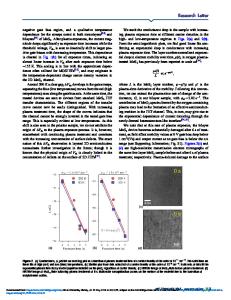Electrical Conduction in Metals and Semiconductors
Electrical transport through materials is a large and complex field, and in this chapter we cover only a few aspects that are relevant to practical applications. We start with a review of the semi-classical approach that leads to the concepts of drift vel
- PDF / 1,367,171 Bytes
- 27 Pages / 547.146 x 686 pts Page_size
- 84 Downloads / 356 Views
Electrical Con 2. Electrical Conduction in Metals and Semiconductors
A good understanding of charge carrier transport and electrical conduction is essential for selecting or developing electronic materials for device applications. Of particular importance are the drift mobility of charge carriers in semiconductors and the conductivity of conductors and insulators. Carrier transport is a broad field that encompasses both traditional ‘bulk’ processes and, increasingly, transport in low dimensional or quantized structures. In other chapters of this handbook, Baranovskii describes hopping transport in low mobility solids such as insulators, Morigaki deals with the electrical properties of amorphous semiconductors and Gould discusses in detail conduction in thin films. In this chap-
2.1
Fundamentals: Drift Velocity, Mobility and Conductivity .................................
20
2.2
Matthiessen’s Rule ..............................
22
2.3
Resistivity of Metals ............................. 2.3.1 General Characteristics............... 2.3.2 Fermi Electrons .........................
23 23 25
2.4
Solid Solutions and Nordheim’s Rule .....
26
2.5
Carrier Scattering in Semiconductors .....
28
2.6
The Boltzmann Transport Equation .......
29
2.7
Resistivity of Thin Polycrystalline Films ..
30
2.8
Inhomogeneous Media. Effective Media Approximation ....................................
32
2.9
The Hall Effect .....................................
35
2.10 High Electric Field Transport .................
37
2.11
Avalanche ...........................................
38
2.12
Two-Dimensional Electron Gas .............
39
2.13
One Dimensional Conductance ..............
41
2.14
The Quantum Hall Effect.......................
42
References ..................................................
44
ter, we outline a semi-quantitative theory of charge transport suitable for a wide range of solids of use to materials researchers and engineers. We introduce theories of “bulk” transport followed by processes pertinent to ultra-fast transport and quantized transport in lower dimensional systems. The latter covers such phenomena as the Quantum Hall Effect, and Quantized Conductance and Ballistic Transport in Quantum Wires that has potential use in new kinds of devices. There are many more rigorous treatments of charge transport; those by Rossiter [2.1] and Dugdale [2.2] on metals, and and Nag [2.3] and Blatt [2.4] on semiconductors are highly recommended.
Part A 2
Electrical transport through materials is a large and complex field, and in this chapter we cover only a few aspects that are relevant to practical applications. We start with a review of the semi-classical approach that leads to the concepts of drift velocity, mobility and conductivity, from which Matthiessen’s Rule is derived. A more general approach based on the Boltzmann transport equation is also discussed. We review the conductivity of metals and include a useful collection of experimental data. The conductivity of nonuniform materials such a
Data Loading...





